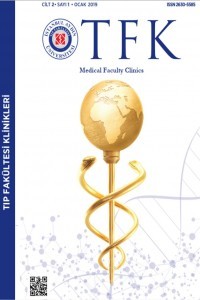Mezenkimal Tümörlerin Tanı ve Ayırıcı Tanısında Yeni İmmünohistokimyasal Belirteçlerin Öneminin Değerlendirilmesi
Amaç: Mezenkimal neoplazmaların tanısı, nadir olmaları ve birbirinden farklı morfolojileri nedeniyle en deneyimli patologlar için bile zordur. Çalışmanın amacı, yeni bulunan immünohistokimyasal belirteçler ve 2013 WHO sınıflaması kullanılarak daha önce sarkom tanısı almış olguları yeniden değerlendirmektir.
Gereç ve Yöntemler: 2000-2015 yılları arasında, ekstremitelerde yumuşak doku sarkomu tanısı alan 183 olgu, 2013 WHO sınıflaması kullanılarak yeniden değerlendirildi. Histopatolojik örnekler yeni immünohistokimyasal belirteçler (TLE1, MUC4, MDM2, CDK4, TFE3, STAT6, INI1) ile analiz edildi. Morfolojik özellikler ve nihai tanı önceki histopatolojik değerlendirme ile karşılaştırıldı.
Bulgular: Bu serideki 38 olguda yeni immünohistokimyasal belirteçler uygulandıktan sonra tanı değişti. En dikkat çekici değişiklik leiomyosarkom ve liposarkom gruplarında tespit edildi.
Sonuç: Yumuşak doku sarkomları, deneyimli patologlar için bile tanı sırasında güçlükler göstermektedir. Yanlış tanı oranını azaltmak için bu zorlu süreç, immünohistokimyasal belirteçlerin uygun şekilde uygulanmasıyla desteklenmelidir. Yeni gelişen immünhistokimyasal belirteçlerle dikkatli inceleme gereklidir.
Anahtar Kelimeler:
Yumuşak Doku Sarkomları, İmmunohistokimya, WHO 2013
The Evaluatıon of Importance of New Immunohistochemıcal Markers For The Dıagnosis and Dıfferentıal Dıagnosis of Mesenchymal Tumors
Objectives: The diagnosis of the mesenchymal neoplasms, due to their rarity and variations of their morphology, is challenging for even the most experienced pathologists. The aim of the study is to reevaluate the cases with previous diagnosis of sarcoma using newly found immunohistochemical markers and 2013 WHO classsification.
Material and Methods: 183 cases who were diagnosed to have soft tissue sarcomas of the extremities between 2000-2015 were reevaluated using 2013 WHO classification. The histopathologic specimens were analyzed with the new immunohistochemical markers (TLE1, MUC4, MDM2, CDK4, TFE3, STAT6, INI1). The morphologic features and the ultimate diagnosis were compared with the previous histopathologic evaluation.
Results: The diagnosis was changed in 38 cases in this series after the application of the new immunohistochemical markers. The most remarkable alteration was detected in the groups of leiomyosarcoma and liposarcoma.
Conclusion: Soft tissue sarcomas exhibit difficulties during diagnosis even for experienced pathologists. This challenging process should be supported with the appropriate application of the immunohistochemical markers in order to decrease the rate of misdiagnosis. The careful examination with the newly developing immunohistochemical markers is required.
Keywords:
Soft tissue sarcomas, immunohistochemistry, WHO 2013,
___
- 1. Goldblum JR, Folpe AL, Weiss S. Enzinger and Weiss’s Soft Tissue Tumors, 6th ed., China, Mosby; 2014.
- 2. Parker SL, Tong T, Bolden S, Wingo PA. Cancer statistics. CA Cancer J Clin 1996; 46:3-4.
- 3. Jemal A, Siegel R, Ward E. Cancer statistics, CA Cancer J Clin 2006; 56:106.
- 4. Ross JA, Severson RK, Davis S. Trends in the incidence of soft tissue sarcomas in the United States from 1973 through 1987. Cancer 1993; 72:486.
- 5. Ferrari A, Sultan I, Huang TT. Soft tissue sarcoma across the age spectrum. A population-based study from the surveillance epidemiology and end results database. Pediatr Blood Cancer 2011; 57:943-9.
- 6. George L, Leona D. An Update on the application of newly described Immunohistochemical markers in soft tissue pathology. Arch Pathol Lab 2015; 106-121.
- 7. Fletcher CDM, Bridge JA, Hogendoorn PCW, et al. WHO Classification of Tumours of Soft Tissue and Bone. IARC Press: Lyon; 2013.
- ISSN: 2630-5585
- Başlangıç: 2018
- Yayıncı: İstanbul Aydın Üniversitesi
Sayıdaki Diğer Makaleler
Naziye CEYHAN, Seda BAKTIR, Yıldız ANALAY AKBABA, Başak BİLİR KAYA
Sevil KARABAĞ, Kivilcim ERDOGAN, Mehmet Ali DEVECİ, Gülfiliz GÖNLÜŞEN
Kök Hücrelerde DNA Hasarı ve Onarımı
Beste YILDIRIM, Ceren YILDIZ, Leyla YILDIZ, Umut YILDIRIM, Alper YILMAZ, Ayla AÇIKGÖZ
Doğum Ağrısını Azaltmada Kullanılan Bir Gevşeme Tekniği: Hipnozla Doğum
Nezihe KIZILKAYA BEJİ, Gizem KAYA, Ayşe YILDIZ
COVID 19 PANDEMİ SÜRECİNDE TIP EĞİTİMİ VE BIR TIP FAKÜLTESİ DENEYİMİ
Murat KALEMOGLU, Ecem KALEMOGLU
Tekrarlayan pankreatit ile erişkin dönemde tanı alan kistik fibrozis olgusu
